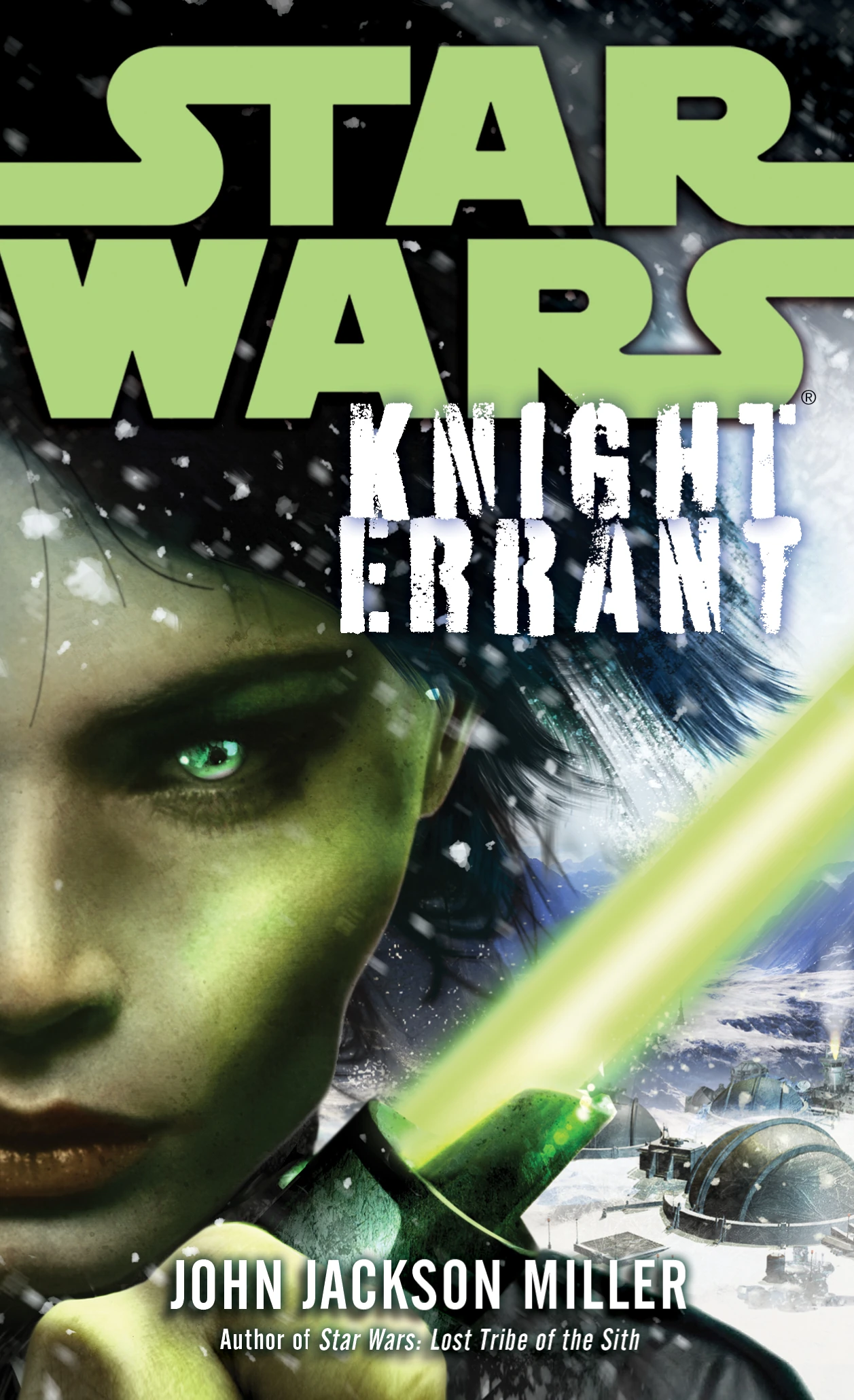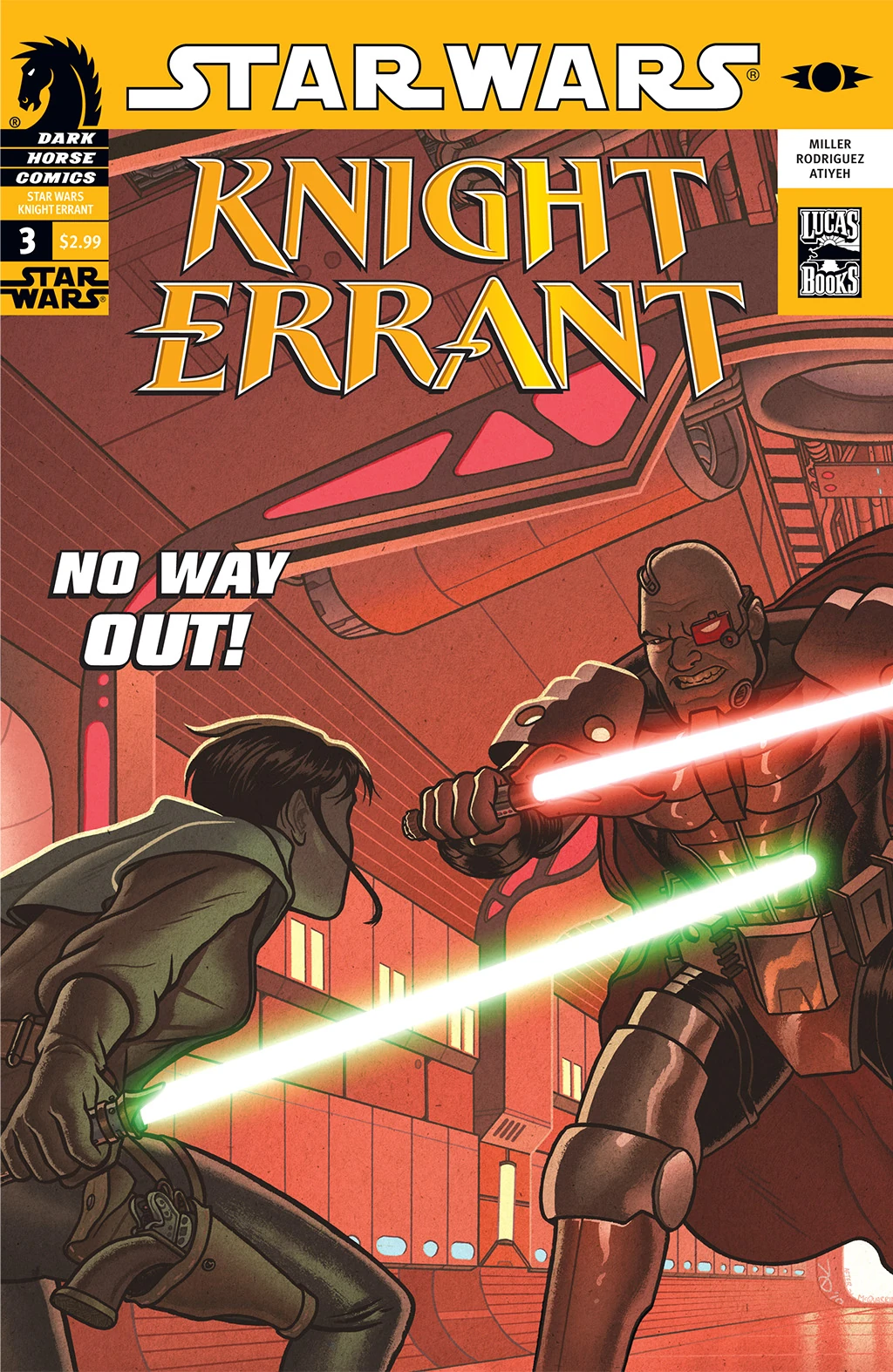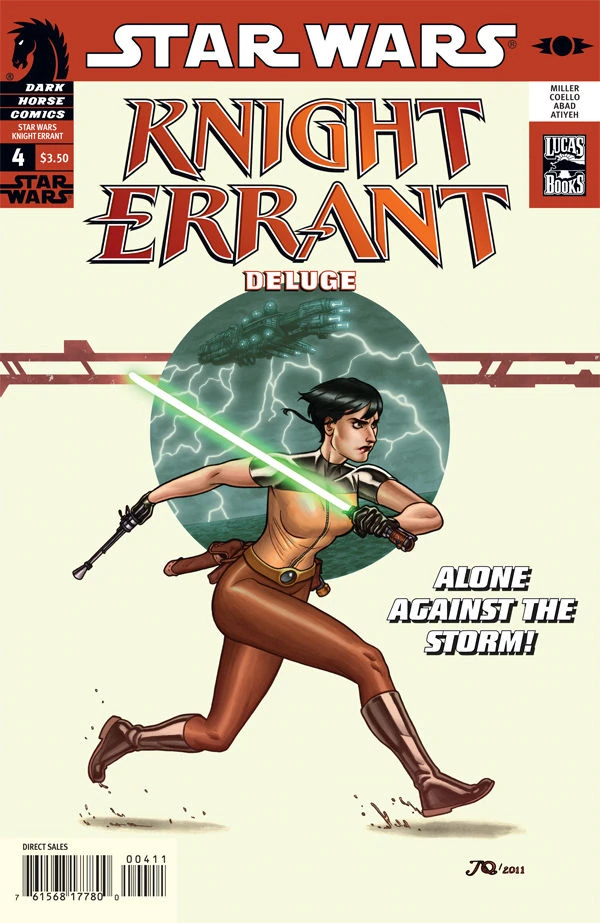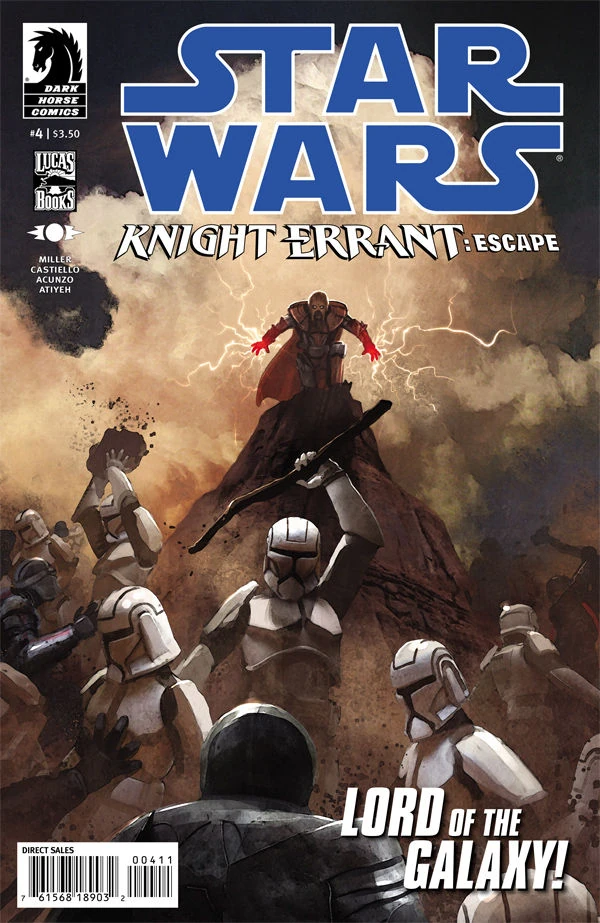As I continue my chronological read-through of Star Wars Legends books, I want to now discuss the Knight Errant series: the adventures of a lone Jedi, stuck fighting many insane Sith in their home territory.
For this write-up, I read the following material:
I read the comics as issues and the novel in paperback. There was a 0-issue distributed at the "Celebration V" convention in 2010, but it was not made widely available, and was essentially a condensed version of issue 1. A short story, called Influx, was once posted online but has since become unavailable.
Knight Errant follows the story of Kerra Holt, a Jedi Knight who has been trapped behind the lines in a war against many Sith.
Almost a millennium earlier, long after the fall of the Sith Empire we knew in the Star Wars: The Old Republic video games, a Jedi Master named Phanius left the Jedi Order and fell to the Dark Side. He became the Sith Lord Darth Ruin, united various Sith factions, converted many Jedi, and began the thousand-year-long New Sith Wars. During this conflict, the Republic came very close to collapsing. However, 900 years into the conflict, any semblance of a united Sith Empire had collapsed as Sith Lords began feuding among themselves.
Knight Errant is set in an area of space dominated by several Sith Lords, the majority of whom are descended from one grandparent: Vilia Calimondra. These siblings and cousins vie for control of their grandmother's territory; she decreed that the heir of her empire was her descendant who expanded her influence the most, and she favours those that obey her and spread her legacy.
While the Republic and its Jedi are focussed on defending what remains of their territory, a team of Jedi warriors occasionally conducts raids into Sith space, aimed at keeping them unstable. Kerra Holt is one of these Jedi, and her Master, Vannar Treece, is their leader.
In Aflame, Kerra's team is sent to destroy the munitions plants of Sith Lord Daiman, but they are interrupted by a separate attack by Daiman's brother, Lord Odion. In the chaos, Kerra is the only Jedi that manages to survive. She manages to prevent Daiman and Odion from acquiring a new stock of explosives and saves many civilian lives. Alone in the territory of this Sith family, Kerra continues her crusade against them, aiming to save lives as much as hurt Sith.
In the Knight Errant novel, Kerra finds herself caught up in a war between Daiman and Odion, but is confused when the two pair up to defeat another Sith. She escapes Daiman's territory with several hundred young students, and eventually finds herself in the territory of Lord Arkadia, who reveals to Kerra how these local Sith are in competition with each other, but also subservient to grandmother (adoptive or otherwise) Vilia.
In Deluge, Kerra returns to her homeworld Aquilaris, occupied by Daiman. She learns of a drug, called Deluge, that has spread across Sith planets, making previously-productive slaves completely useless. Kerra teams up with a team of former Republic pilots who spread both food aid and the drug into Sith space. She must also fight a Hutt named Zodoh, who uses weapons that generate storms to flood planets, and hopes to carve an Empire for himself in Sith territory.
Finally, in Escape, Kerra infiltrates Odion's death cult to track down a dangerous artifact that will help Odion destroy all life in the Galaxy. She also searches for her parents, whom she thought dead, but were in fact also tracking the artifact.
While the story did not end on a cliffhanger, the saga of Kerra Holt could have easily continued.
The author's take on the different Sith was fascinating. The brothers Odion and Daiman experienced the Dark Side of the Force in such unique ways, with Odion literally being pained by life and being driven to extinguish it where possible and Daiman believing himself to be the creator of the entire universe and unconscious controller of all people. There are also the twins Quillan and Dromika, who impose their will directly on others on their planet, Arkadia, who has harnessed chaos by demanding her citizens constantly change jobs, and Malakite, who rules an empire of misshapen Sith experiments. Because of these traits, these Sith, their armies, and the worlds they rule are unique and interesting. It also makes them great villains, whom we can understand but have no desire to be sympathetic towards.
I'm disappointed that this series ended when it did. Many more stories could have been told in this setting. The adventures of Kerra Holt were not over. I understand that the decision to end the series was not imposed by the company but was simply because the author was done and was busy with other projects, but I would have still preferred more, perhaps with a conclusion that tied the story to the Darth Bane books.
Another problem I had was that, by this point, Dark Horse had stopped publishing ongoing series and instead produced miniseries that you read in order. This allegedly made the books more accessible (people are more likely to buy the issue if it's labelled #1 vs. labelled #6 or #11), but it eliminates the possibility of random one-shot stories. Some of the best individual Star Wars issues were complete stories told in a single issue. This was impossible in that new format. Dark Horse would also leave large gaps between miniseries, which risked making people forget what was happening in the stories. I had the same problem with Dawn of the Jedi. I much prefer a regular ongoing series, with sequential numbering and a regular release schedule, as Marvel is doing with Star Wars now.
Follow @C_Andrew_H
For this write-up, I read the following material:
- Knight Errant: Aflame 1-5 (comic by John Jackson Miller, 2010-2011)
- Knight Errant (novel by John Jackson Miller, 2011)
- Knight Errant: Deluge 1-5 (comic by John Jackson Miller, 2011)
- Knight Errant: Escape 1-5 (comic by John Jackson Miller, 2012)
I read the comics as issues and the novel in paperback. There was a 0-issue distributed at the "Celebration V" convention in 2010, but it was not made widely available, and was essentially a condensed version of issue 1. A short story, called Influx, was once posted online but has since become unavailable.
 |
| Cover of Knight Errant novel. Image from Wookieepedia. |
Story:
Knight Errant follows the story of Kerra Holt, a Jedi Knight who has been trapped behind the lines in a war against many Sith.Almost a millennium earlier, long after the fall of the Sith Empire we knew in the Star Wars: The Old Republic video games, a Jedi Master named Phanius left the Jedi Order and fell to the Dark Side. He became the Sith Lord Darth Ruin, united various Sith factions, converted many Jedi, and began the thousand-year-long New Sith Wars. During this conflict, the Republic came very close to collapsing. However, 900 years into the conflict, any semblance of a united Sith Empire had collapsed as Sith Lords began feuding among themselves.
Knight Errant is set in an area of space dominated by several Sith Lords, the majority of whom are descended from one grandparent: Vilia Calimondra. These siblings and cousins vie for control of their grandmother's territory; she decreed that the heir of her empire was her descendant who expanded her influence the most, and she favours those that obey her and spread her legacy.
While the Republic and its Jedi are focussed on defending what remains of their territory, a team of Jedi warriors occasionally conducts raids into Sith space, aimed at keeping them unstable. Kerra Holt is one of these Jedi, and her Master, Vannar Treece, is their leader.
 |
| Cover of Knight Errant: Aflame 3, featuring Kerra Holt and Lord Odion. Image from Wookieepedia. |
In Aflame, Kerra's team is sent to destroy the munitions plants of Sith Lord Daiman, but they are interrupted by a separate attack by Daiman's brother, Lord Odion. In the chaos, Kerra is the only Jedi that manages to survive. She manages to prevent Daiman and Odion from acquiring a new stock of explosives and saves many civilian lives. Alone in the territory of this Sith family, Kerra continues her crusade against them, aiming to save lives as much as hurt Sith.
In the Knight Errant novel, Kerra finds herself caught up in a war between Daiman and Odion, but is confused when the two pair up to defeat another Sith. She escapes Daiman's territory with several hundred young students, and eventually finds herself in the territory of Lord Arkadia, who reveals to Kerra how these local Sith are in competition with each other, but also subservient to grandmother (adoptive or otherwise) Vilia.
In Deluge, Kerra returns to her homeworld Aquilaris, occupied by Daiman. She learns of a drug, called Deluge, that has spread across Sith planets, making previously-productive slaves completely useless. Kerra teams up with a team of former Republic pilots who spread both food aid and the drug into Sith space. She must also fight a Hutt named Zodoh, who uses weapons that generate storms to flood planets, and hopes to carve an Empire for himself in Sith territory.
 |
| Cover of Knight Errant: Deluge 4. Image from Wookieepedia. |
Finally, in Escape, Kerra infiltrates Odion's death cult to track down a dangerous artifact that will help Odion destroy all life in the Galaxy. She also searches for her parents, whom she thought dead, but were in fact also tracking the artifact.
While the story did not end on a cliffhanger, the saga of Kerra Holt could have easily continued.
Thoughts:
In previous blog posts about Star Wars, I've written extensively about world-building. While the movies did a lot to set up what the Galaxy writ large looked like during the original trilogy era and prequel era, there was not much to go on when it came to the ancient past. Supplemental material would establish a few facts, like the New Sith Wars that nearly collapsed the Republic, but generally the writers are free to describe the universe as they wish. No story had ever been told set in this exact era. The Darth Bane novels (which we will explore next, but were written earlier) take place 32 years later under a new united Sith Empire that does not exist yet in Knight Errant. So John Jackson Miller has a lot of freedom to build the world as he sees fit.The author's take on the different Sith was fascinating. The brothers Odion and Daiman experienced the Dark Side of the Force in such unique ways, with Odion literally being pained by life and being driven to extinguish it where possible and Daiman believing himself to be the creator of the entire universe and unconscious controller of all people. There are also the twins Quillan and Dromika, who impose their will directly on others on their planet, Arkadia, who has harnessed chaos by demanding her citizens constantly change jobs, and Malakite, who rules an empire of misshapen Sith experiments. Because of these traits, these Sith, their armies, and the worlds they rule are unique and interesting. It also makes them great villains, whom we can understand but have no desire to be sympathetic towards.
 |
| Cover of Knight Errant: Escape 4, with Odion destroying all life. Image from Wookieepedia. |
I'm disappointed that this series ended when it did. Many more stories could have been told in this setting. The adventures of Kerra Holt were not over. I understand that the decision to end the series was not imposed by the company but was simply because the author was done and was busy with other projects, but I would have still preferred more, perhaps with a conclusion that tied the story to the Darth Bane books.
Another problem I had was that, by this point, Dark Horse had stopped publishing ongoing series and instead produced miniseries that you read in order. This allegedly made the books more accessible (people are more likely to buy the issue if it's labelled #1 vs. labelled #6 or #11), but it eliminates the possibility of random one-shot stories. Some of the best individual Star Wars issues were complete stories told in a single issue. This was impossible in that new format. Dark Horse would also leave large gaps between miniseries, which risked making people forget what was happening in the stories. I had the same problem with Dawn of the Jedi. I much prefer a regular ongoing series, with sequential numbering and a regular release schedule, as Marvel is doing with Star Wars now.
Next:
The next Legends stories I'll be reading are the saga of Darth Bane. But before that, I'll talk more about various New Canon comics, including more arcs of the main series, the Vader Down crossover, the end of the Darth Vader series, a miniseries about Chewbacca, and another about Obi-Wan Kenobi and Anakin Skywalker before the Clone Wars.Follow @C_Andrew_H
Comments
Post a Comment